Leading Kaldheim Set Design
My latest set design lead is more akin to my first lead with Dominaria. Design boundaries are not being pushed in Kaldheim like in my last two leads, War of the Spark and Ikoria: Lair of Behemoths. As I hope you've seen by now, there are still plenty of new and exciting things. I had a lot of confidence in the core of the handoff both creatively and mechanically that Set Design received. I think we brought that to life with a set full of fun, resonant, and varied designs. Thanks to my Set Design team and so many others here at Wizards of the Coast in making it happen.
Ready to be inspired by Norse and Viking lore? Let's take a look at how the various aspects of the set came together.
Foretell
Foretell did not change much from vision design where we had figured out that foretell played better with the card staying hidden and playable on any subsequent turn, not just on your following turn.
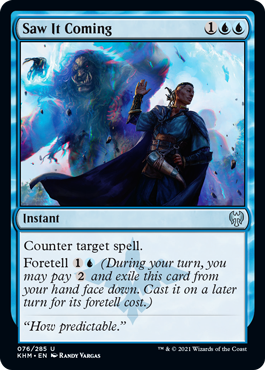
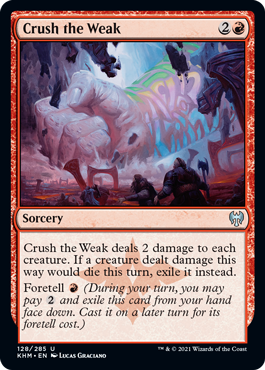
Foretell is satisfying in ways that are not immediately apparent. There is something rewarding about having a specific card set aside for much of the game. The longer the game progresses, the more intrigue there is about it. What could it be? If it were the card that I thought it was, they would have used it there, right? It's especially cool when the game goes on for many turns and you make a strong play with a foretell card you had clearly been planning around, and then all players know how patient you were in springing your trap.
While those moments are great, there are also many times where you foretell a card, especially a permanent card, and then cast it in the next few turns. The reward is often simply in letting you spend two mana on a turn when you did not have anything better to do and reaping great value for the mana spent the turn you cast the card. Foretell works nicely as a smoothing mechanic in making sure you have something to do on turn two, letting you achieve effects with fewer total sources of mana on the board than for what we typically give you, and in helping you make progress while getting the colors of mana you need.
In many ways, foretell has similarities to morph, a mechanic I also enjoy. Attention is focused on the hidden info of a specific card, and they share gameplay-smoothing characteristics. Like morph, you will have to get in the habit of revealing any foretold cards at the end of the game you have not yet cast for their foretell cost.
Unlike morph, you are not putting your cards at risk in the form of a Shock-able creature. Admittedly, it also takes a bit longer to start doing damage with non-hasty foretell creatures than it does with morphs. Once foretold, your cards with foretell are not only safe from removal but also from discard spells as they wait in exile. Foretell has two big pluses. First, two mana versus three mana for the setup is a big difference. Second, foretell yields instant and sorcery designs.
In Kaldheim, foretell paved the way for a mini theme in white and black that rewards you for casting your second spell each turn. The reduced cost in casting foretold cards means that you can combo spells together and create big effects with little mana and likely cast two spells in a turn. It was fun seeing players rewarded for setting up that play pattern.
There are a lot of foretell cards in the set. This was important for keeping the guesswork we wanted with the mechanic. Fortunately, including so many felt like an easy decision given how popular the mechanic was in testing.
Modal Double-faced Cards
Gods being portrayed as modal double-faced cards (MDFCs) with the God on the front and an associated permanent on the back struck me as a great idea from the start. While we entertained other ideas for additional MDFCs, there were concerns over there being fatigue from too many double-faced cards in Standard, so we stuck to our best efforts with these Gods and finished the dual land cycle we started in Zendikar Rising.
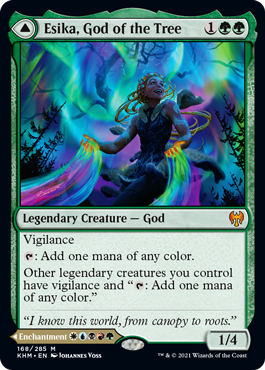
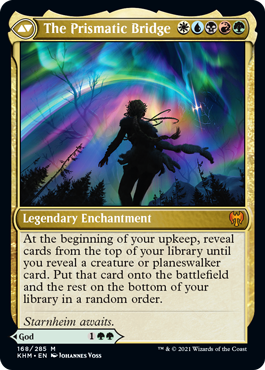
The MDFCs in Zendikar Rising do a wonderful job of smoothing out draws by providing lands early and spells in the late game, or as needed. The MDFCs in Kaldheim do not have quite that versatility, but as a result, we can offer you better rates for the spells. One of the more elegant aspects of having the Gods as MDFCs is in providing an easy workaround to drawing multiples of a legendary card. Ordinarily, you might be stuck sitting on the second copy of your legendary card, but with these MDFCs, you can play the card on its other side. We leaned into that play pattern by often making each side of the card play well with the other side. Besides having different mana costs on each side, we also found designs where each side might excel in different games states, increasing the likelihood of a satisfying way to deploy at least one side of your card.
Boast
Boast was not in the set at handoff from the Vision Design team. The mechanic stemmed from a suggestion made by Bryan Hawley. Bryan was earnest about making sure we had an aggressive attacking combat mechanic and proposed a mechanic called "glory." The intent and execution were very close to the mechanic in its final form. After some tuning and arriving at the name "boast," I fell in love with this mechanic as a component of the set. In Bryan's version, you had to use the ability while the creature was attacking, but we decided it was cleanest to let you use the ability anytime in the turn the creature with boast was declared as an attacker. Otherwise, the ability encouraged use in a narrow window after damage was dealt and while it was still an attacker.
Another small change we made to the mechanic late in design was changing it from an ability word to a full-fledged keyword. Without delving into the rules, this meant we could reference boast on other cards.
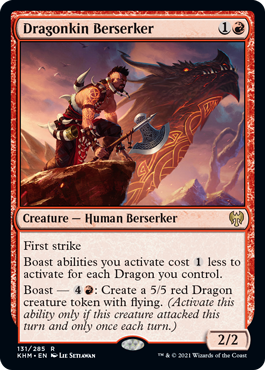
Boast mostly found a home in white, red, and black. In filling out designs for boast, we mostly avoided putting it on naturally evasive creatures since it played best when putting your creature at risk. We wanted to encourage combat tricks to survive and live to boast another day. The repeatable, turn-to-turn nature of boast meant that we needed to be careful with effects that could lead to snowballing. We needed such effects to come at high enough costs that the game might also slow down, giving the opponent a chance to recover.
Snow
Speaking of "snowballing," snow was not in the vision design handoff at all. Whenever I listened to folks pondering what a Norse and/or Viking-inspired Magic setting might include, snow kept coming up quickly near the top of the list.
I was oblivious to some of the internally perceived skepticism about the mechanic and embarked down a snow-filled path. Given that Modern Horizons was also using this mechanic, I felt we should try to innovate here where we could. Early in my exploration of snow, I pondered what it could mean for non-permanent cards. While the end results are not particularly groundbreaking, I am happy with the results of the snow instants and snow sorceries we have added to the game.
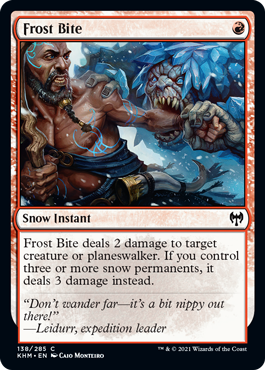
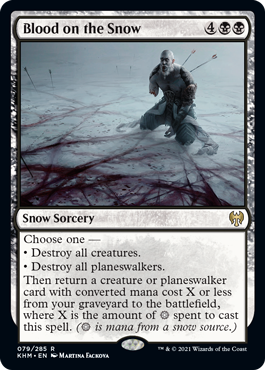
There was a temptation to frequently refer to snow cards, especially having created snow sorceries and snow instants. Unfortunately, this felt like another tribe to be tracking in a set that already had a significant tribal component. As a result, we limited snow cards to caring mostly about spending snow mana or snow lands where it played well. There were some exceptions where we decided the best gameplay meant still caring about the type line on non-lands. Snow is most concentrated in the colors blue, green, and black but is found in all colors in the hope that players will find new ways to tackle their favorite format with more snowy mana bases.
Sagas
The word "saga" is derived from Old Norse. That felt like plenty of justification to do them here. With a focus on realms each highlighting a color pair, I was eager to simply explore the design space of two-color Sagas, interweaving colors on them for the first time. In the end, there was at least one Saga set on each realm, but some of the Sagas were better suited to telling stories of realms that did not align with their color pair.
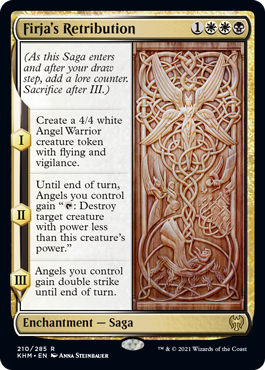
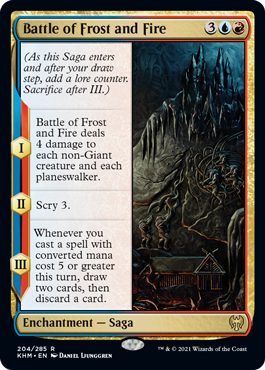
Choose a clan
At the start of set design, we had inherited a very heavy component of cards that asked you to choose a creature type. While individually, many of these cards were very fun, they were taking up too much mental real estate during Limited gameplay. While that one time you chose Pegasus made for a good story, it was offset by the games you struggled to remember what was in your deck or had to keep double checking how many of each creature type you'd already drafted.
We kept some "choose a creature type" cards at higher rarities and changed more to be in a form where it was less important as to what creature types you might subsequently draw. We changed the wording on some such that it would just check which tribe you had the most of. Overall, caring about your creature subtype just became less of what the Limited environment was about, but we kept our favorites for Constructed.
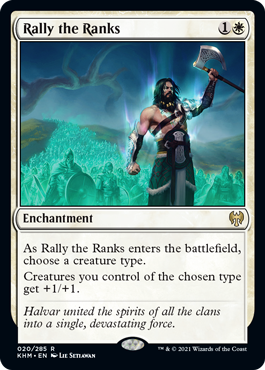
While the open-endedness of "choose a creature type" is often great fun with novel moments, one limitation is that modern tribal design speaks more to tribal cards being evocative of that specific tribe. Each tribe is doing a specific thing with its rewards pointing to that. That is very hard to do in designs where the bonus applies to any tribe. As we cut down on some of the choosing components, we added in more support for the tribes in the set both mechanically and creatively. One of the first additions I made in the set was creating the uncommon cycle of equipment that could each come with a creature type we were highlighting here. Beyond that, we tried to make more cards to make Giants feel more like Giants and Elves feel like Elves, especially when they're referring to their own tribe. Additionally, I decided that the added card content we created for outside Booster Draft should primarily focus on supporting Elves, Giants, Dwarves, and Shapeshifters. We also experimented with double tribal cards when the card text was a good match for affecting other creatures of either subtype on a creature to create more deck-building possibilities.
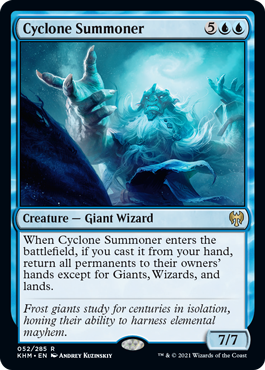
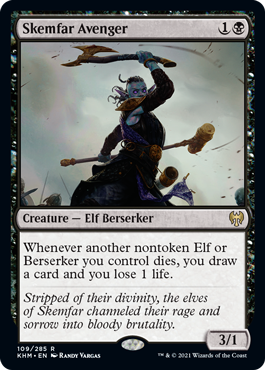
At the risk of resembling Modern Horizons in another way, we also added the changeling mechanic during set design to better bridge the gap between various tribal strategies, and because it felt like a good match to our plans for Shapeshifters in blue and green on the realm of Littjara.
Single card designs
There are several other small elements like the Runes and cards exiling creatures from graveyards conceived as a pyre mechanic to tribute the fallen. These elements add a lot of texture to the set as well.
Ultimately, much of what I love most about Kaldheim is in various one-off designs. There are a lot of charming cards that speak to unique characters and events. We crafted a lot of designs to speak to the feel of each realm and flesh out what that realm and its denizens were all about. I have a flair for pushing legendary designs, and this was a fertile setting for it.
Uh-oh! What is this doing here?
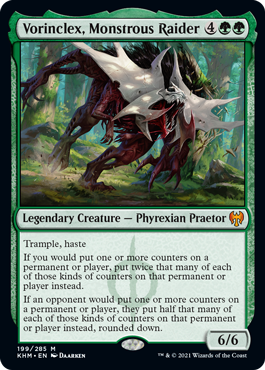
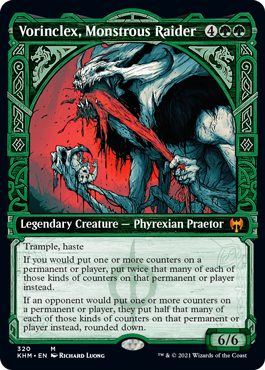
Perhaps you were just warming up to my story, but after much internal debate on the rounding in that last sentence of Vorinclex text, we decided this fearsome Praetor would bring all opposing Sagas to a pause. So, until next time
Thanks for reading. I hope you enjoy Kaldheim!
Dave Humpherys

